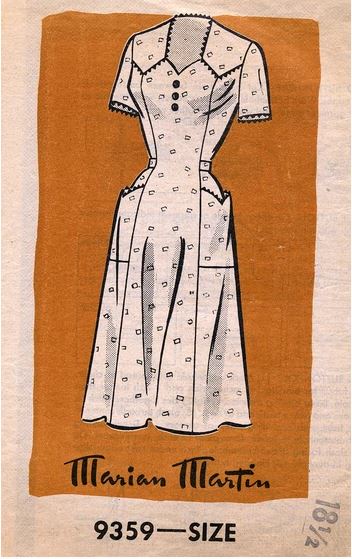
If you have spent any time bemoaning the fact that ordinary clothes don’t fit older women’s bodies, you are not alone. I have found complaints stretching back to 1900, the start date of my research, and I am sure that it would be easy to find earlier examples without looking very hard.
The search for a better fit for older figures is also not new. When you look through the fascinating Journal of Home Economics (available on the website Hearth) you can find many studies where researchers address this problem. One interesting example, published in 1951, was called “Functional House Dresses” by Clara Edaburn.
To figure out what to change, researchers asked women want they wanted in an ideal house dress. Women over fifty responded that they wanted house dresses that were suitable for shopping and entertaining friends as well as housework, even if that meant the dresses were harder to clean. They wanted big, practical pockets close to the waist. Older women complained about the fit of the arms on most dresses, which were often too tight and hindered movement. However, they did not want to substitute sleeveless styles because “they preferred to cover the upper arm for the sake of appearance.” (424)
The clever home economists came up with a proposed style with longer arms and a bias gusset (an inset cut on the diagonal) under the arm in order to ease movement. Of course, such an idea never made it into wide scale production—I suspect because it would have increased the cost of this basic garment. I couldn’t even find an existing sewing pattern that included this clever detail. You would have to make your own.


I cannot really contemplate buying RTW for anything beyond fine knits generally as the fit is never right. My bug bear is the emphasis on the waist seam in dresses- empire lines are more flattering for me now – so I figure the waist seam is either the economy of the factory cut re fabric or the cult of the young re waist seam fit (although seeing these dresses on some I don’t think they fit younger women that well either).
thanks for the tip on the bias gusset!
I think the most practical design for a house dress is along the lines of an Amish or Mennonite every day dress. But I’d elasticize the waistband.
Mass-produced clothing manufacturers refuse to accept that not all women gain weight in the same places. Having measured literally thousands of bodies for costumes — many of them chorus members who were not young and lithe — I can say that some women store fat above the hip (which results in a thickening midriff and large upper arm measurements) and some store fat around the hips and thighs. (This may not be true of women who are clinically obese, because I haven’t measured many.) Manufacturers tend to produce garments for larger women as if weight gain were evenly distributed all over our bodies, including our shoulders and backs! (It’s my utterly unresearched opinion that garments produced cheaply in countries where few women (and few fitting models) are over 5′ 6″ tall and curvy are the worst offenders.) For women of the “pear” type, or women with a large bust but normal shoulders and arms, buying separates is still the best option. For too-tight armholes, the basic square or diamond-shaped gusset can be added to any pattern that has both a side seam and a sleeve with a seam that intersects the side seam. See https://sewingladyblog.com/tag/underarm-gusset/